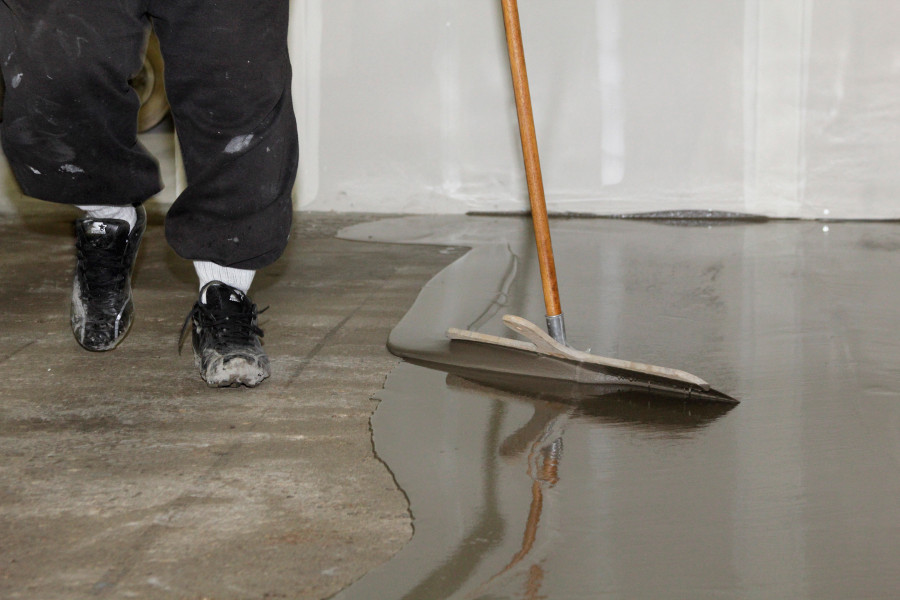Picture this: you’re envisioning a gorgeous new floor in your home, maybe a sleek concrete finish that adds a modern touch. But your existing floor is wood, and you’re left wondering, “Can I just pour self-leveling concrete over it?” It’s a question that’s sparked endless debates and DIY mishaps, and the answer, as with most things in home improvement, is “it depends.” This comprehensive guide will navigate the complexities of using self-leveling concrete on a wood floor, separating fact from fiction, and giving you the knowledge to make an informed decision.

Image: www.floorleveling.ca
Self-leveling concrete, often referred to as SLC, has surged in popularity for its ability to create flawlessly smooth surfaces for various applications. But when it comes to wood floors, a bit more consideration is needed. Unlike pouring concrete over a solid foundation, wood floors present unique challenges: movement, moisture, and structural integrity. Understanding these factors is crucial for a successful outcome.
Understanding the Challenges
Expansion and Contraction: The Dance of Wood
Wood is a natural material, and its primary characteristic is its ability to expand and contract with changes in humidity. Think of it as a living thing, breathing with the environment. Wood floors, even with proper installation, will shift slightly over time. This movement, if not accounted for, can lead to cracks in the self-leveling concrete, compromising its structural integrity.
Moisture: The Silent Saboteur
Moisture is another enemy when using concrete over wood. Wood, especially older flooring, often absorbs moisture from the surrounding environment. This can affect the bond between the concrete and the wood, leading to delamination or even warping.

Image: viewfloor.co
Structural Integrity: Foundation for Success
The structural integrity of your existing wood floor is critical. If your floor isn’t adequately solid and stable, self-leveling concrete will simply magnify any existing issues. This can create unevenness and eventually lead to cracking, making the project a costly disaster.
When It Might Be Possible
Before you dismiss the idea altogether, know that there are scenarios where using self-leveling concrete on wood floors can be successful. Here’s a breakdown:
New Wood Floors
If you have a newly installed wood floor, it is significantly less challenging to apply SLC. The wood will have had less time to moisture-related expansion and contraction, and its structural integrity is generally stronger. However, remember that it’s still crucial to account for future movement.
Proper Subfloor Preparation
The key to success lies in meticulous preparation. Ensuring a solid, level, and moisture-resistant subfloor is paramount. This might involve various techniques, including:
<ul>
<li><strong>Adding a moisture barrier:</strong> This could be a layer of polyethylene sheeting to prevent moisture from migrating from the wood into the concrete.</li>
<li><strong>Using a bonding agent:</strong> Applying a bonding primer designed specifically for concrete and wood enhances adhesion and creates a stronger bond.</li>
<li><strong>Leveling the subfloor: </strong> Existing unevenness needs to be tackled before laying the self-leveling concrete. This could involve using shims, leveling compound, or other techniques. </li>
</ul> Consideration of Low-Moisture Concrete
Some self-leveling concrete formulations are specifically designed for low-moisture applications, making them ideal for wood floors. These options often contain additives that help with moisture resistance and reduce the risk of delamination.
When You Should Proceed With Caution
While the possibility exists, there are situations where pouring concrete over wood is highly discouraged. Proceed with caution in these instances:
Old Wood Floors
Older wood floors are more prone to moisture issues and may have structural weaknesses that can compromise the integrity of the concrete layer. While it might seem tempting to save money by re-using an old floor, the potential for complications far outweighs the cost savings.
Significant Movement or Unevenness
If your wood floor has a noticeable level of unevenness or significant movement, attempting to apply self-leveling concrete is highly risky. The concrete will likely crack and fail, wasting both time and money.
Moisture Levels
Excessive moisture in the wood subfloor is a major inhibitor when applying self-leveling concrete. If the moisture level is too high, the concrete will not properly cure and may become brittle, leading to cracking and peeling.
Expert Insights and Actionable Tips
If you’re still determined to explore this option, seeking professional advice from a licensed contractor specializing in concrete and flooring is essential. They can assess your specific situation, suggest appropriate techniques, and guide you through every step of the process.
Always prioritize safety and quality. Invest in high-quality materials, follow the manufacturer’s instructions meticulously, and allow adequate drying time. Remember, shortcuts in this process will cost you in the long run.
Can Self Leveling Concrete Be Used On Wood Floors
Conclusion
Pouring self-leveling concrete over wood floors can be a viable option for certain scenarios, but it’s not a walk in the park. Thorough research, meticulous preparation, and expert guidance are crucial. Ultimately, weigh the risks and benefits carefully. Consider whether alternative flooring solutions, like a new wooden subfloor, might be a more reliable and cost-effective approach.
Have you faced this decision yourself? Share your thoughts and experiences in the comments below. Let’s help each other navigate this complex yet fascinating world of DIY projects!






